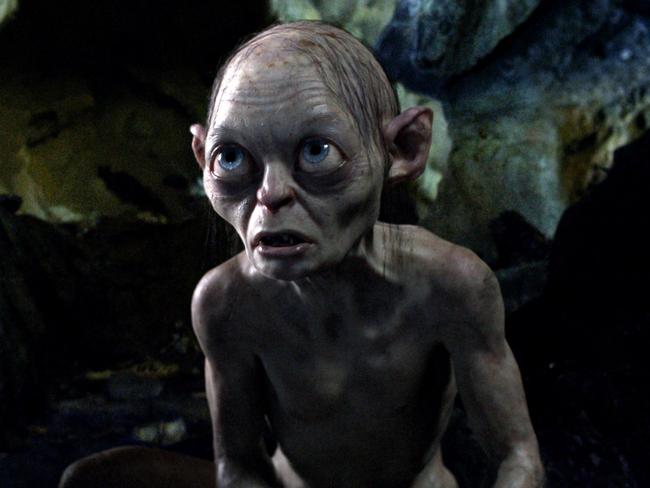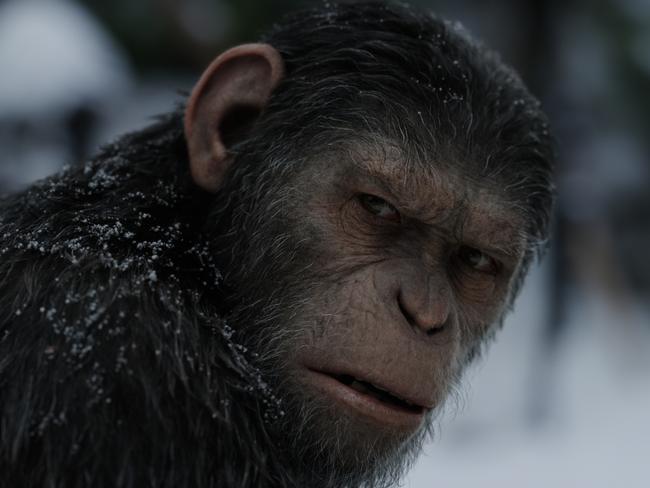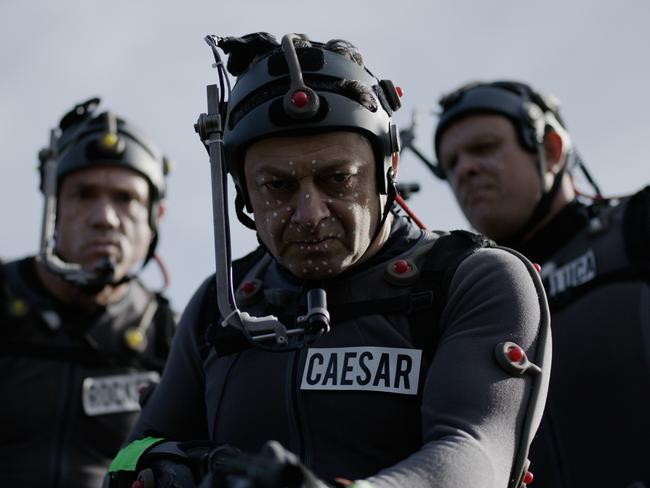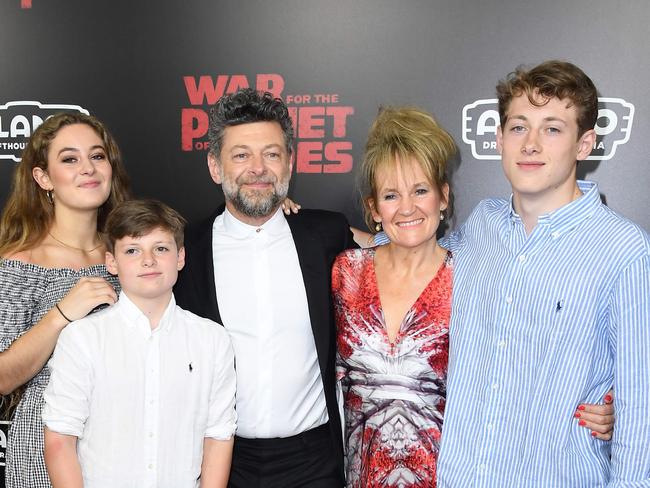Performance capture guru Andy Serkis helped revolutionise film with Gollum, King Kong and Caesar
ANDY Serkis has turned modern motion capture technology into an art form. Now he’s teaching other actors how to behave like animals.
New Movies
Don't miss out on the headlines from New Movies. Followed categories will be added to My News.
AS the world’s foremost motion capture performance genius, Andy Serkis has assumed many masks during his career.
His extraordinary skills have seen him assume the form of a giant gorilla (King Kong), a drunken sea captain (Captain Haddock in The Adventures of Tintin), a mysterious and evil overlord (Supreme Leader Snoke in new Star Wars series) and a highly evolved chimpanzee (Caesar in the Planet of the Apes trilogy).
And it’s all because he can inject life into a special suit with sensors that track his body and face movements so they can drive a computer-generated character.
But the one character Serkis can’t put behind is the one that kicked it all off.
More than 15 years after he first created the twisted, tortured, hobbit-gone-bad Gollum in Peter Jackson’s Lord of the Rings trilogy, Serkis is still getting asked to do THAT voice.
Recently, the actor hilariously read out Trump tweets as Gollum on The Late Show with Stephen Colbert. He’s lost count of the times he’s been asked to do voicemail messages over the years.
“That character is kind of like my picture of Dorian Gray in reverse,” Serkis says with a laugh over the phone from his native London. “He’s never going to go away.”

It probably doesn’t help that he can see himself when he looks at some of the trailblazing characters he has created on the big screen.
“Gollum is pretty reflective of my face — believe it or not — or certain of my features. And Caesar’s are very much so,” he admits.
Pioneered by New Zealand effects company Weta Digital, Gollum was revolutionary, cutting edge technology when the Lord of the Rings films were released, sparking debate as to the effect it would have on the industry.
Where did the acting stop and the animation begin? Should motion capture performances be eligible for awards? Would there come a time actors wouldn’t be needed at all?
Serkis, who also runs The Imaginarium Studios, a hi-tech London facility that specialises in motion capture, has long said the technique is just another actor’s tool like make-up or prosthetics. He believes the method has become so entrenched and accepted now that A-list actors a queuing up to try it. Serkis is currently directing Oscar winners Cate Blanchett and Christian Bale in a motion-capture version of The Jungle Book and says they were thrilled at the chance to put on the suit to become a snake and a panther respectively.
“What’s happened is that it is so central to filmmaking now — you think about the Marvel Universe or most big tentpole movies use performance capture in some way or another,” he says. “More and more A-list actors use it and love it and understand it. What they realise very quickly is that there is no difference between acting in a live action movie or using performance capture cameras — it’s just a different technology to capture your performance.”
Serkis has taken the technique to ever greater heights in the Planet of the Apes movies, in which he plays Caesar, the leader of a highly evolved band of apes pitted against the remnants of humanity who have survived a plague and are now competing to be the dominant species on the planet. Serkis’ performance has evolved along with the character.
In the first film, Dawn of the Planet Of the Apes, he was inspired by a real domesticated chimpanzee. But as Caesar became more intelligent in the sequel, Rise of the Planet of the Apes, and now the finale, War For the Planet of the Apes, he sought out more human touchstones.

Serkis based his performance on a real chimpanzee called Oliver who (in the 1970s) was the subject of a lot of experiments “because people believed him to be almost like a missing link,” says Serkis. “He was so human in his behaviour. But then when we went into Dawn and to War as (Caesar) was becoming more human, I was looking for more human leader comparisons. So I did very much think about Gandhi and also Barack Obama — I thought he was a very strong example of the empathetic nature of a leader and the ability to not necessarily lead with force but to lead by listening and to empower the troops. That is the strength of great leadership.”
Making the most recent movie was a rewarding experience for Serkis, but not necessarily an enjoyable one. Filming outside at night in the Canadian winter wearing only a thin performance-capture suit was bad enough, but even worse was getting into the mindset of a world-weary leader who has lost his family and is driven by revenge and retribution.
“This one was particularly tough because of the darkness of the material and where I had to go,” Serkis says. “Plus I was going through some personal loss in my life at the same time, the shoot was kind of a bleak time for me. But having come out of it I am very proud of the work that went on. It was a very intense shoot.”

Serkis admits that in the past he has struggled to shake off characters, particularly the grim and disturbing ones such as Moors Murderer Ian Brady, who he played in the 2006 telemovie Longford. But as a husband and father of three, he’s learned how to not let the darkness he wallows in at work leach into his family life.
“I tend to dig deep into characters so it does become intense,” he says. “I have to say that as I have grown older I have found ways to cope with that. As a younger actor you can get totally lost in a character because what you are doing is chemically tricking yourself to believe it’s true so it can be a fine balance sometimes. When you are a younger actor and there is nothing else to live for other than what you do — I have now had a family for many years and as you grow older and you have to multitask, you find different coping mechanisms that enable you to shift in and out of these extreme situations and back into normal life.”

In War For the Planet of the Apes, Caesar is pitted against Woody Harrelson’s The Colonel, a hard-nosed military man who leads a squad of zealots and will stop at nothing to ensure the survival of the human race over the emerging apes.
Serkis says the messages of the Planet of the Apes movies speak to fractured and divisive modern times and have a particular resonance in this era of terror, hate crimes, Brexit and Trump.
“We live in a world of fundamentalism,” Serkis says. “There is a leap of faith that makes you do extraordinary things to make the survival of your kind happen. But at the same time, what (director Matt Reeves) has done brilliantly is not be judgmental. There are no winners in war, there are only survivors. It isn’t so much that the apes are bad or the humans are good or vice versa — there are good and bad in all religions there are good and bad in all peoples or species. That’s one of the great messages of the movie.”
WAR FOR THE PLANET OF THE APES OPENS TODAY
Originally published as Performance capture guru Andy Serkis helped revolutionise film with Gollum, King Kong and Caesar


